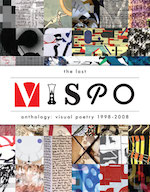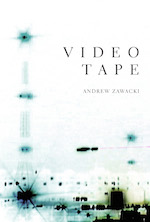“Beautiful Evidence – Vispo and Videotape”
 The Last Vispo Anthology: Visual Poetry 1998-2008
The Last Vispo Anthology: Visual Poetry 1998-2008
Nico Vassilakis & Crag Hill, editors
Fantagraphics, 2012
In her essay “Broken English,” Heather McHugh explores the role of fragment in poetry, including the artwork of English artist Tom Phillips in A Humument: A Treated Victorian Novel. Phillips’ work goes beyond simple erasure—the pages of A Humument are, with their patterns, depictions, and odd geometries, works of art themselves. Their attraction is visual, and within these images the observer finds, almost like speech bubbles, fragments of text. In McHugh’s words, these fragments of text “[allude] to the Romantic operation while performing a deconstructive one.”
McHugh’s terminology of the Romantic and deconstructive came to mind as I approached the Last Vispo Anthology: Visual Poetry 1998-2008. The twentieth century saw the dissolution of Romantic conventions of both image and language, and it’s fitting that, in the form of visual poetry, the new century would see the reconstitution of these fragments. In his introduction to the anthology, editor Nico Vassilakis writes, “Letters lose their chemical word attraction, their ability to bond to one another, to cohere into words, and they begin to perform mutated experiments on each other and themselves.”
As editors, Vassilakis and Crag Hill have created a forum where the works included are able to perform this work of mutation on each other. If “all poetry is fragment,” as McHugh proposes, the Vispo Anthology suggests that all fragment is poetry, whether the fragment be written or visual.
As a relative newcomer the world of visual poetry, my closest exposure to something like this anthology is the (now out-of-print) anthology Imagining Language (MIT Press, 2001). Many of the excerpts in Imagining Language are the attempts of poets such as Velimir Khlebnikov, Victor Hugo, and bpNichol to explain how letters are colored, sometimes by sound, sometimes through synesthesia. Vispo, on the other hand, seeks to disorder the letter, to free it from these latent associations. While the goal of Imagining Language is often to create order, Vispo’s project is one of “exploding the alphabet.”
So what does an exploded alphabet look like? And how can it be read? Luckily, Crag Hill provides a useful coda to his introduction, which provides three steps for reading the visual poem: “First, the whole page at once, then the parts of the whole, then both together, as a recombination of fragments.”
In some of the work, such as Oded Ezer’s “The Message,” letters quite literally lift from the page and become three dimensional. Others, such as Reid Wood’s “Bab(b)el-On” and Irving Weiss’s “Turret of Babble,” suggest that the accretion of characters has the ability to obscure or even negate their meaning. Some pieces, such as Holly Crawford’s “Duchamp Without the Words,” take letters out of the equation all together.
The Vispo Anthology suggests that our symbols, be they letters or depictions, gain new force in juxtaposition. The result is works such as “As Bad As Making Someone Give Up A Decided Suicide,” in which Suzan Sari gives symbolic clues that defy simple definition or narrative: there is Y repeated in different typefaces, what might be a melted revolver, perhaps a window curtain cord, and what is definitely two lavatory symbols practicing the Kama Sutra.
Is this a poem? The parasol-wielding women falling backwards off a U in J. M. Calleja’s “Dizziness”—is she a poem? What of the geometrically apportioned city park, its green spaces punctuated with benches and trees, in Fernando Aguilar’s “Ecological Sonnet”?
Perhaps the greatest feat of the Vispo Anthology is its expansion of the discussion of how we define poetry. In his introduction, Vassilakis writes that one of the goals of the anthology is to inform “the young fidgeter of letter construction” that “Vispo is viable poetic form.” In this goal, the anthology is a definite and exciting success.
In his interrogative essay, “Unfetter’d,” Charles Alexander suggests that asking what a poem is is not nearly as useful as considering what a poem does. This emphasis is on the action. Alexander writes, and the Vispo Anthology as a whole seems to confirm, that we ultimately understand what poetry is through its effect: “Can a poem not be a geometry of angles? Can it not disappear around the corner of our knowing, taking us to the edge of our being?” (BC)
—
 Videotape
Videotape
Andrew Zawacki
Counterpath, 2013
Reading Videotape, Andrew Zawacki’s fourth full-length book of poetry, is like staring at a screen displaying one imperfect, video-jittered image after another, being startled by the sight of one’s reflection there, noticing the landscape behind that reflection, and then leaning in to scan that horizon instead of turning around. A book-length sequence, it is arranged into two pairs of individually titled alternating tracks, with notes to follow. Each A Track is arranged vertically—narrow and justified—while each B Track runs horizontally along the bottom of the page
Its controlling metaphors all have to do with technology’s mediation of perception, but its focus is always on the human. Instead of looking through a camera’s lens at the city of Paris—surely one of the most photographed cities—it peers back at the “faces occluded by point and shoot cameras.”(9) Shifts like this create opportunities to see what fades or becomes inaccessible:
a split-
screen track, in 8
mm or Beta-
max: a trace
of how it
was & when &
nothing to play it on
(21)
Action too is mediated. Events take place not in a scene, but in how a scene is seen, as in a “—zip pan / over the plane trees”. (25) The most potent metaphors unspool from technologies of reproduction of one sort or at other, illuminated “by this rakish / twilight, its Xeroxed / veneer”. (27) Like the work of Robert Irwin or James Turrell, “first light” is “Deskjet scarlet & halogen / white”. (30) And although these artists are not among the many image-makers the book takes note of, they are a useful point of reference, since language, the material of Videotape—like light, the material of those artists—changes the world by apprehension.
And since no reproduction is perfect, the world of these poems is defined not just by the imperfection of memory, but by what it adds to an image. Its errors propagate to become a part of remembered events: a “world / that is not / world enough & is / not not / a world”. (32) It is the world as re-made in some future consciousness, a version of Keats’ urn or Yeats’ gold-hammered bird.
Not only sight, but also sound is mediated: “waves breaking in lullaby from a mobile set to ‘nature’”. (40) And in that same section, moving across the globe with inhuman speed, the speed of thought outpaces us from Montparnasse to the Niger, always via the subnuclear pulse of metaphor.
For some readers the book’s screens may be too removing—its techno-nostalgic and timebound diction might seem at odds with its aim to write some timeless code about our drive to extend ourselves further and deeper into the world using those screens. There is an obsession with “settings”: time, stops, iso’s, landscape. Reminder after reminder that the world comes to us “encoded” (43) and via “Firewire.” (45) One section posits that “the world exists to end up on DVD” (52)—a once-cutting-edge and now obsolete medium. But this returns us to a key metaphor in the book: that the location of meaning is at once hyper-important and transient. It fades but leaves a trace. This is the world not only through a screen, but of it:
Luster across
the floorboards—
IP address 79.92.111
.153—, on the other side
of the cloister door: turn
the flood,
the spot light on: you can’t see
it because it
‘s there
(“Glassscape” 59)
A willing reader will be reminded that there is not, after all, any direct way to perceive—that even “the a.m.’s / advance” is measured “in 30 / -gallon bio- / degradable bags of / longleaf pine straw”. (66) That we apprehend one phenomenon only against another. Which reminds us, in turn, that life is not digital; that analogy is at the heart of what it is to be human. (AB)
